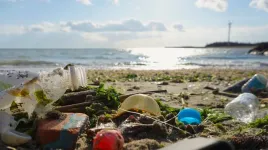(Press-News.org) Feeding children peanut products regularly from infancy to age 5 years reduced the rate of peanut allergy in adolescence by 71%, even when the children ate or avoided peanut products as desired for many years. These new findings, from a study sponsored and co-funded by the National Institutes of Health’s National Institute of Allergy and Infectious Diseases (NIAID), provide conclusive evidence that achieving long-term prevention of peanut allergy is possible through early allergen consumption. The results were published today in the journal NEJM Evidence.
“Today’s findings should reinforce parents’ and caregivers’ confidence that feeding their young children peanut products beginning in infancy according to established guidelines can provide lasting protection from peanut allergy,” said NIAID Director Jeanne Marrazzo, M.D., M.P.H. “If widely implemented, this safe, simple strategy could prevent tens of thousands of cases of peanut allergy among the 3.6 million children born in the United States each year.”
The new research findings come from the LEAP-Trio study, which builds on the seminal results of the Learning Early About Peanut Allergy (LEAP) clinical trial and the subsequent LEAP-On study, both sponsored and co-funded by NIAID.
During the LEAP trial, half of the participants regularly consumed peanut products from infancy until age 5 years, while the other half avoided peanut during that period. Researchers found that early introduction of peanut products reduced the risk of peanut allergy at age 5 by 81%. Subsequently, children from LEAP who participated in LEAP-On were asked to avoid eating peanut products from ages 5 to 6 years. Investigators found that most children from the original peanut-consumption group remained protected from peanut allergy at age 6.
The LEAP investigators designed the LEAP-Trio study to test whether the protection gained from early consumption of peanut products would last into adolescence if the children could choose to eat peanut products in whatever amount and frequency they wanted. Those children who were allergic to peanut at age 6 were advised to continue avoiding it.
The study team enrolled 508 of the original 640 LEAP trial participants—nearly 80%—into the LEAP-Trio study. The children averaged 13 years of age at enrollment. Two hundred and fifty-five participants had been in the LEAP peanut-consumption group and 253 in the LEAP peanut-avoidance group.
The LEAP-Trio study team assessed the adolescents for peanut allergy primarily through an oral food challenge. This involved giving participants gradually increasing amounts of peanut in a carefully controlled setting to determine if they could safely consume at least 5 grams of peanut, the equivalent of more than 20 peanuts. The study team also surveyed participants about their recent patterns of peanut consumption and verified the self-reports through measurements of peanut in dust from participants’ beds, a technique previously validated by LEAP investigators.
The LEAP-Trio investigators found that 15.4% of participants from the early childhood peanut-avoidance group and 4.4% from the early childhood peanut-consumption group had peanut allergy at age 12 or older. These percentages reflected 38 of 246 participants from the peanut-avoidance group and 11 of 251 from the peanut-consumption group. (Complete data was unavailable for 11 of the 508 participants enrolled.) These results showed that regular, early peanut consumption reduced the risk of peanut allergy in adolescence by 71% compared to early peanut avoidance.
The researchers also found that although participants in the LEAP peanut-consumption group ate more peanut products throughout childhood than the other participants overall, the frequency and amount of peanut consumed varied widely in both groups and included periods of not eating peanut products. This demonstrated that the protective effect of early peanut consumption lasted without the need to eat peanut products consistently throughout childhood and early adolescence.
For detailed advice on how to safety introduce peanut into an infant’s diet, consult the Addendum Guidelines for the Prevention of Peanut Allergy in the United States.
The NIAID-funded Immune Tolerance Network (ITN) conducted LEAP, LEAP-On and LEAP-Trio under the leadership of Gideon Lack, M.D. Dr. Lack is a professor of pediatric allergy at King's College London and head of the Children's Allergy Clinical Academic Group in the KHP Institute of Women and Children's Health at Evelina London.
Additional information about the LEAP-Trio study is available at ClinicalTrials.gov under study identifier NCT03546413.
NIH, NIAID funded the study under grant numbers UM1AI109565, UM2AI117870, and U01AI178772. The National Peanut Board, Atlanta, and The Davis Foundation, London, co-funded the trial.
Reference: G Du Toit et al. Early peanut introduction for allergy prevention: Follow-up to adolescence. NEJM Evidence DOI: 10.1056/EVIDoa2300311 (2024).
NIAID conducts and supports research—at NIH, throughout the United States, and worldwide—to study the causes of infectious and immune-mediated diseases, and to develop better means of preventing, diagnosing and treating these illnesses. News releases, fact sheets and other NIAID-related materials are available on the NIAID website.
About the National Institutes of Health (NIH): NIH, the nation's medical research agency, includes 27 Institutes and Centers and is a component of the U.S. Department of Health and Human Services. NIH is the primary federal agency conducting and supporting basic, clinical, and translational medical research, and is investigating the causes, treatments, and cures for both common and rare diseases. For more information about NIH and its programs, visit https://www.nih.gov/.
NIH...Turning Discovery Into Health®
END
Tsukuba, Japan—The nucleus accumbens plays a pivotal role in motivational behavior and sleep regulation, modulated by adenosine A2A receptors (A2AR). Hence, selective A2AR regulation within this brain region could control sleep and motivation. However, A2ARs are distributed across various organs, including the heart, posing challenges for precise brain-specific modulation without genetic interventions.
A research team led by Professor Michael Lazarus and Associate Professor Tsuyoshi Saitoh (TRiSTAR Fellow) from the Institute of Medicine and the International Institute for Integrative Sleep Medicine (WPI-IIIS) at the University ...
SAN ANTONIO — May 28, 2024 —Southwest Research Institute has created a comprehensive data analysis tool to help metropolitan areas curb urban heat islands (UHIs) and pursue mitigation methods for especially vulnerable populations. This internally funded project was a collaboration with the City of San Antonio.
UHIs occur when dense concentrations of pavement and buildings absorb heat and raise surrounding temperatures. Without green spaces to provide a cooling effect, UHI temperatures can exceed other areas by as much as 20 degrees Fahrenheit, which could be dangerous to residents during summer.
“Tackling UHIs goes ...
A study published in Contemporary Economic Policy reveals significant benefits gained from the first implementation of the state-run retirement savings program in Oregon, known as OregonSaves, in 2017.
OregonSaves is available to Oregon workers whose employers do not offer a workplace retirement plan, self-employed individuals, and others. Businesses that do not offer retirement plans are required to automatically enroll employees, but workers can opt out at any time.
The analysis found that the program substantially boosted retirement savings among previously ...
Harnessing energy from plasma requires a precise understanding of its behavior during fusion to keep it hot, dense and stable. A new theoretical model about a plasma’s edge, which can become unstable and bulge, brings the prospect of commercial fusion power closer to reality.
“The model refines the thinking on stabilizing the edge of the plasma for different tokamak shapes,” said Jason Parisi, a staff research physicist at PPPL. Parisi is the lead author of three articles describing the model that were published in the journals Nuclear Fusion and Physics of Plasma. The primary paper focuses on a part of the plasma called ...
The World Heart Federation (WHF) is honoring Valentin Fuster, MD, PhD, President of Mount Sinai Heart and Physician-in-Chief of The Mount Sinai Hospital, with its Lifetime Achievement Award for 2024. This top honor recognizes his remarkable contributions to the WHF mission, and to the entire cardiovascular disease community for his dedication to combating this disease worldwide.
The WHF will present Dr. Fuster with this award on Saturday, May 25, during the World Heart Summit in Geneva, Switzerland.
“I am proud of this award, particularly because it represents Mount Sinai’s worldwide scientific contributions and dedication to advancements in the cardiovascular ...
Photochromic compounds, which change their color when exposed to light, have been widely used as photoswitches to control different properties of materials. Nonlinear photochromic compounds, characterized by a nonlinear response to the intensity of incident light, have attracted special attention among researchers as the nonlinearity leads to enhanced contrast and improved spatial resolution in photochromic reactions. It also allows for multiple photochromic properties in a single molecule with a single light source. These qualities have made them valuable in nonlinear optical and holographic elements, super-resolution microscopy, and biomedical applications.
The simplest ...
BELMONT, Mass. (May 28, 2024) Binge-eating disorder is the most prevalent eating disorder in the United States, but previous studies have presented conflicting views of the disorder’s duration and the likelihood of relapse. A new five-year study led by investigators from McLean Hospital, a member of the Mass General Brigham healthcare system, showed that 61 percent and 45 percent of individuals still experienced binge-eating disorder 2.5 and 5 years after their initial diagnoses, respectively. These results contradict previous ...
SPOKANE, Wash. – Greater use of pharmacists to treat minor illnesses could potentially save millions of dollars in health care costs, according to new research led by Washington State University. The findings also indicate a way to improve healthcare access by expanding availability of pharmacists’ clinical services including prescribing medications, amid an ongoing shortage of primary care providers.
The study found that care for a range of minor health issues – including urinary tract infections, shingles, animal bites and headaches – costs an average of about $278 less when treated in pharmacies compared to patients with similar ...
Optical analysis and machine learning techniques can now readily detect microplastics in marine and freshwater environments using inexpensive porous metal substrates. Details of the method, developed by researchers at Nagoya University with collaborators at the National Institute for Materials Sciences in Japan and others, are published in the journal Nature Communications.
Detecting and identifying microplastics in water samples is essential for environmental monitoring but is challenging due in part to the structural similarity of microplastics with natural organic compounds derived from biofilms, algae, and decaying organic matter. Existing detection methods ...
Scientists have come a step closer to identifying the mysterious origins of the ‘slow’ solar wind, using data collected during the Solar Orbiter spacecraft’s first close journey to the Sun.
Solar wind, which can travel at hundreds of kilometres per second, has fascinated scientists for years, and new research published in Nature Astronomy, is finally shedding light on how it forms.
Solar wind describes the continuous outflow of charged plasma particles from the Sun into space – with wind travelling at over 500km ...






